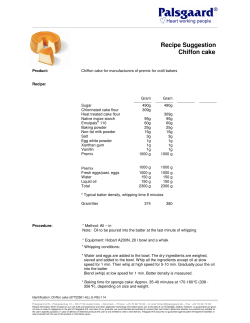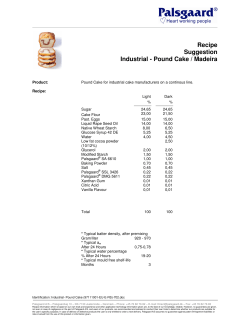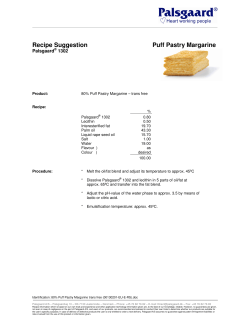
Cake Doughnuts > INFORMATION SHEET DEFINITION
Cake Doughnuts > INFORMATION SHEET DEFINITION Doughnuts are a snack food made from deep-fried sweet dough. Usually circular with a hole in the middle, but also made in the shape of balls, fingers and stars. Hot doughnuts may be dusted with sugar and spice; cold doughnuts may be glazed with icing or filled with jam, custard or similar. Cake doughnuts are chemically leavened, tender and have a more cake-like texture with a crisp brown crust. DESCRIPTION A vertical cross section of a doughnut can be divided into three sections: 1. Fried Zone = Crust or outer surface which is crisp and medium brown in colour. It has been exposed directly to the hot fry fat, resulting in a loss of moisture and the absorption of high levels of fat. 2. Baked Zone = Makes up the bulk of the doughnut. It is very cakelike, has absorbed little fat, but has been exposed to sufficient heat for leavening action and starch gelatinisation. 3. Inner Zone = Core. A semi-firm dense area which has been exposed to insufficient heat, so leavening is incomplete. It has a high moisture content and during storage some of this moisture will migrate to the surface, affecting the crispness of the doughnut and increasing the breakdown of the sugar coating. HISTORY It is feasible that ancient Egyptians ate doughnuts, as a panel dating to 1000 BC depicts a court bakery where small cakes or dough were being fried. In Germany there is a tradition of Pfankuchen, yeastraised dough pieces which are deep fried. Known as Berliners, these products were enjoyed at carnival times. This product became known throughout Europe and was introduced to the USA by immigrants in early 1900s. During WWII they were brought into the UK by American military personnel. INGREDIENTS INGREDIENT FUNCTION & SPECIFICATIONS (*Based on flour content.) Flour Soft wheat flour and not cake flour is used. It provides structure without excessive toughness. Flour levels are 55–65% of the total mix weight. Soy flour Levels of up to 2%* defatted soy flour are used to increase water absorption and binding. Sugar Provides sweetness, acts as tenderising agents, accelerates browning, binds moisture to assist with extending shelf life and affects fat absorption. Non fat dry milk Added at levels up to 4%* acts as binder and structure builder, provides crust browning and prevents excessive fat absorption by forming a protein seal. Potato starch Typically used at 1.25%*. Very effective water binding, which slows staling and reduces coating break down. Egg yolk Dried egg yolk is the most functional version, as egg whites or whole eggs tend to add toughness. Egg yolk provides richness and tenderness to dough and improves eating quality. Fat Total fat content is derived from either amount added to mix or fat absorbed during frying. Total fat content is 20–25%, which affects tenderness, richness of eating properties and shelf life. There is direct relationship between amount of fat in the mix and amount of fat absorbed during frying. Salt Salt added at 1–1.5%* to enhance flavour. Lecithin Functional emulsifier which controls fat absorption, aids controls of batter flow and symmetry, and acts as a wetting agent to improve mixing. Emulsifiers Most commonly mono- and diglycerides. These function as tenderising agents, extend shelf life and give doughnuts a short bite. Leavening Cake doughnut leavening systems are much faster acting than typical cake baking powder systems as they have a shortened exposure time to baking temperatures. Need to be stable in the dry mix, during floor time and provide maximum leavening during fry time. Example of a leavening blend consists of relatively fast acting acidulant, e.g. sodium acid pyrophospahte (SAPP) and slower acting acidulant, sodium aluminium phosphate (SALP), monocalcium phosphate with a sodium bicarbonate base. BIRT CAKE DOUGHNUTS INFORMATION SHEET | V1.0 2011 >1 Cake Doughnuts > INFORMATION SHEET Mould inhibitors Commonly used are sodium diacetate, sodium propionate, potassium sorbate and sorbic acid. Anti-oxidants Commonly used anti-oxidants are not stable at frying temperatures so their primary function is stabilisation of the doughnut mix or fat prior to use. Water Major ingredient in the preparation of the doughnut batter. Water controls the viscosity of the resulting batter and makes up 38–44% of the mix (based on dry weight). Other Ingredients: Milk replacers (casein, whey, sodium casenate), moisture binders (guar gum, carboxymethyl cellulose) and colour agents. PROCESSING PROCESS DETAILS Mixing The temperature of water must be controlled as this controls the temperature of mix. For uniform mixing and to avoid lumping, the water should be added to the mixing bowl first. Mixing combines all ingredients by initiating hydration of all ingredients. The mixing begins slowly to incorporate the ingredients followed by high speed mixing to develop the batter. The gluten matrix is developed and the batter is gasified by the leavening agent and some air incorporation. The batter will be very thick to start with due to hydration of the flour but then will slack as sugar dissolves and leavening reactions are initiated. Floor time Time between completion of the mixing step and the start of depositing. During this time the hydration process continues and the initial leavening reaction proceeds. As hydration continues the batter stiffens as water is absorbed. Depending on the temperature after 10–20 minutes the hydration rate slows to a point that the batter is stable, which ensures uniform scaling and depositing of doughnuts. Depositing or cutting There are two types of cutter-depositors used in the industry: Gravity depositor: Batter is fed into the cutter by gravity and by a suction action as the cutter opens. A slightly slacker batter is required and can be achieved by addition of extra water to the mix, approximately 1–2 kg/100 kg of dry mix. Pressure depositor: Batter is forced under controlled air pressure into the cutter. The air pressure necessary to achieve the desired doughnut weight provides a measurement of the viscosity of the batter and checks it is consistent. Batter consistency, speed of the cutter stroke, cutter dwell time and length of cutter stroke all affect the amount of batter extruded per stroke. Frying Very important step as the fat becomes the ‘pan’, heat transfer medium and a major product ingredient. During frying moisture is being driven from the batter and fry fat is being absorbed. Frying fat temperature ranges from 188 to 193oC and affects doughnut volume, crust colour, spread and fat absorption. Doughnuts are fried in two stages with first stage (before turning) being slightly hotter and longer than the second stage. Cooling After frying doughnuts are cooled to an internal temperature of 32–35oC. During cooling additional moisture losses occur and doughnuts firm to allow handling for coating and packaging. If doughnuts are not properly cooled then the product will be too tender and moist, allowing breakage, breakdown of coating and weeping in the packaging. Coating & glazing Doughnuts can be coated with a glaze or powdered sugar which, apart from making the doughnut more attractive, also improve the eating quality of the doughnut by providing sweetness. A typical coating sugar may be made up of 76–87% dextrose, 5–8% shortening and 8–16% starch. Packaging Glazed doughnuts must be allowed to dry and cool to room temperature before being packaged, ideally in packaging with ventilation. They should not be packed too tightly as this will cause the glaze to weep. BIRT CAKE DOUGHNUTS INFORMATION SHEET | V1.0 2011 >2 Cake Doughnuts > INFORMATION SHEET FACTORS AFFECTING THE AMOUNT OF FAT ABSORBED FACTOR DETAILS Batter temperature Warm batter absorbs more fat due to greater porosity. Degree of mixing Either under or over mixing will increase the fat absorption. Floor time Old batter will absorb more fat. Operation of cutter Rough cut batter will absorb more fat than a piece with a smooth continuous surface. Temperature of fry fat Fry fat absorption is increased when fry fat temperature is cooler than desired. Frying time The longer the fry time the greater the amount of absorbed fat. Condition of fry fat Old and deteriorated fat will absorb more readily than fresh fat. Amount of fat in the mix Direct relationship between amount of fat in the mix and the amount of fry fat absorbed. The rate of absorbed fat increase being greater than the increase of mix fat. Emulsifier content of mix Increases in emulsifier level causes increases in fat absorption. TROUBLE SHOOTING PROBLEM PROBABLE CAUSE Doughnuts crack Not fried enough on first side or fat too hot. Batter too cold or stiff. Over mixed. Not enough rest time. Improper shape Frying fat level too high or low. Overcrowded kettle or screen. Batter too warm or excessive rest time. Depositor incorrectly mounted. Excessive spread Frying fat too cold or level too low. Batter too warm, too thin or under mixed. High fat absorption Fried too long on first side. Fat too cold or broken down. Batter too cold, too warm or under mixed. Low volume Frying fat level too high. Doughnuts turned too soon. Batter too cold, too stiff, under or over mixed or scaled too light for cutter size. Raw centres Not fried long enough. Batter too cold. Scaled too heavy for cutter size. Uneven colour Not fried long enough on first side or too long on second side. Frying fat too hot or cold or broken down. BIRT CAKE DOUGHNUTS INFORMATION SHEET | V1.0 2011 >3 Cake Doughnuts > INFORMATION SHEET REFERENCES Anonymous 1979. Cake doughnuts II. Mix preparation, scaling, mixing and frying. AIB Research Department Technical Bulletin. Volume I, Issue 7. Anonymous 1990. Doughnut problem solving. Bakers Journal August/September 1990 Anonymous 1991. Doughnuts – It’s so easy to make variety - and profits. British Baker January 19 1991. Ash DJ June 1979. Cake doughnuts I. Formulations. AIB Research Department Technical Bulletin. Volume I, Issue 6. Dubois D 1980. Cake doughnuts III. Frying fat. AIB Research Department Technical Bulletin. Volume II, Issue 7. Dixon J 1983. Cake Donut production a controlled process. Bakers Digest September 13, 1983 BIRT CAKE DOUGHNUTS INFORMATION SHEET | V1.0 2011 >4
© Copyright 2025













